
AS417
Material: porcelain
Dimensions: 14cm D.
Provenance: Private Collection, UK
Notes: This elegant bowl is beautifully painted in coloured enamels with a central gnarled old prunus tree with creamy white blossoms, between striking red hibiscus shrubs. The base has an underglaze blue seal mark of the emperor Qianlong.
Price: POA

AS408
Material: porcelain
Dimensions: 13cm D.
Provenance: Private Collection, UK
Notes: This small bowl is painted in coloured enamels with full blown chrysanthemum and peony blossoms supported by small wild flowers. The base with iron red mark of the Jiangxi Porcelain Company.
Price: £595

Material: porcelain
Dimensions: 13cm D.
Provenance: Private Collection, UK
NotesThis dish is unusually decorated with an illustration of an ensemble of 7 Tang dynasty female musicians playing traditional instruments, including the qin, pipa, xiao, sheng, yunluo, and ruan, whilst a child merrily dances to the music.
Price: £690
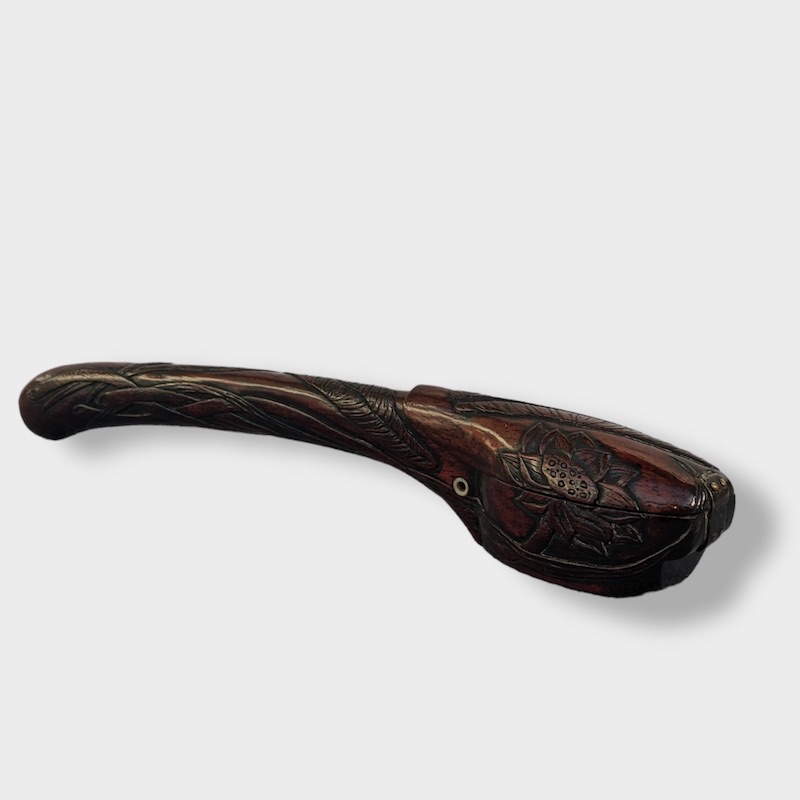
AS412
Material: wood
Dimensions: 15cm
Provenance: Private collection, UK
Notes: Carved with lotus leaf and flower. The yatate of ladle type, the fudezutsu (brush holder) with slightly curved handle, terminating in a sumitsubo (inkwell) with a locally repaired, hinged cover. The wood of a rich dark colour.
Price: £590

AS407
Material: boxwood, buffalo horn
Dimensions: 4.5cm
Provenance: Private Collection, UK
Price: POA

AS393
Material: boxwood, horn
Dimensions: 4cm
Provenance: Private Collection, UK
Notes: signed Ishikawa 石川, depicting two toads, one peering through a hole in the lily pad she's wrapped in, the other clambering over.
Price: £200
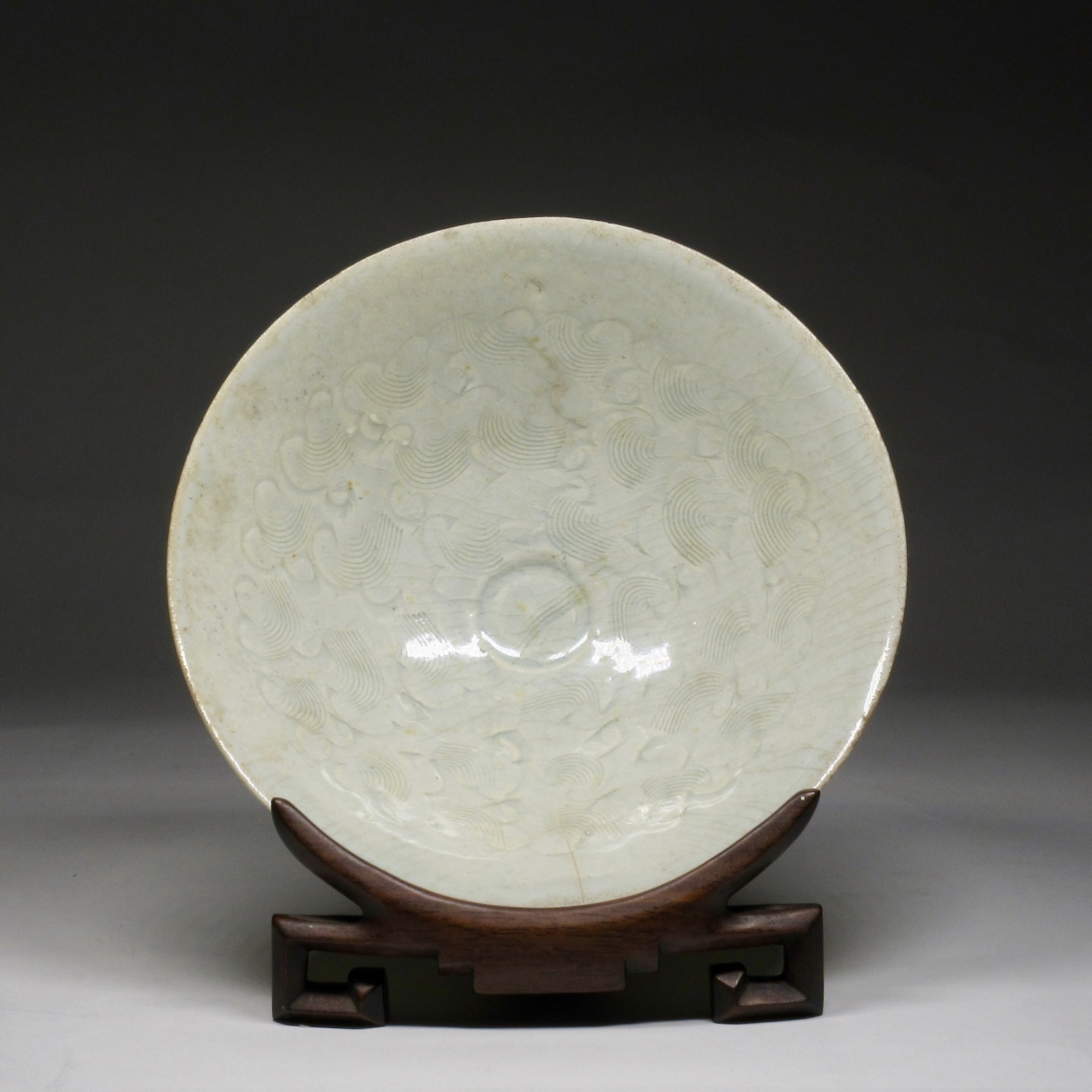
Material: proto-porcelain
Dimensions: 18.4cm D.
Provenance: Private Collection, UK
Notes: Of conical form rising from a short circular foot, this bowl is beautifully carved and combed to the interior with diffused wave designs and covered in the characteristic smooth, translucent blue-green glaze. Old crack.
Price: £550

Material: proto-porcelain
Dimensions: 5.5cm H
Provenance: Private Collection, UK
Notes: Very rare scholar's water dropper in the form of a fruit with textured skin, leaves and stalk. Used to drop water onto freshly ground ink powder for calligraphy or painting.
Price: POA
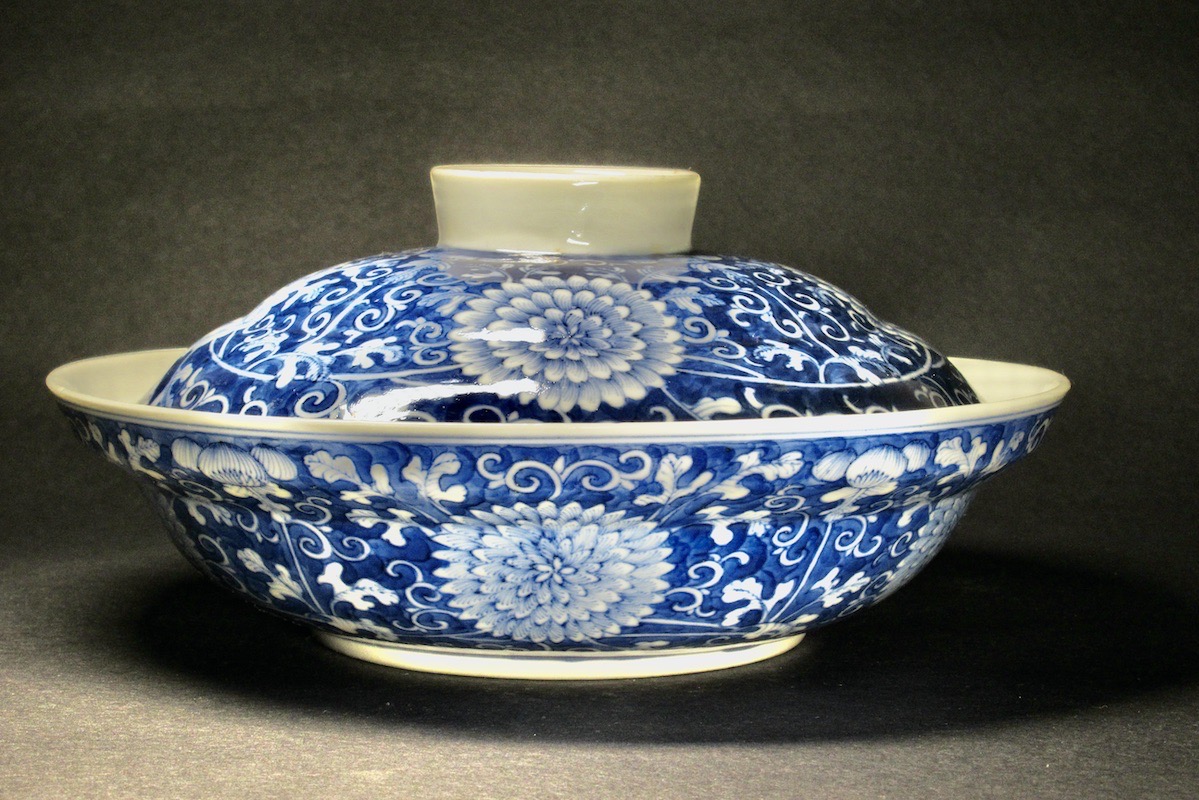
Material: porcelain
Dimensions: 27cm D.
Provenance: Private Collection, UK
Notes: Painted in lovely tones of blue with scrolling chrysanthemums, a favourite flower of the Chinese, emblematic of happiness and vitality.
Price: £350
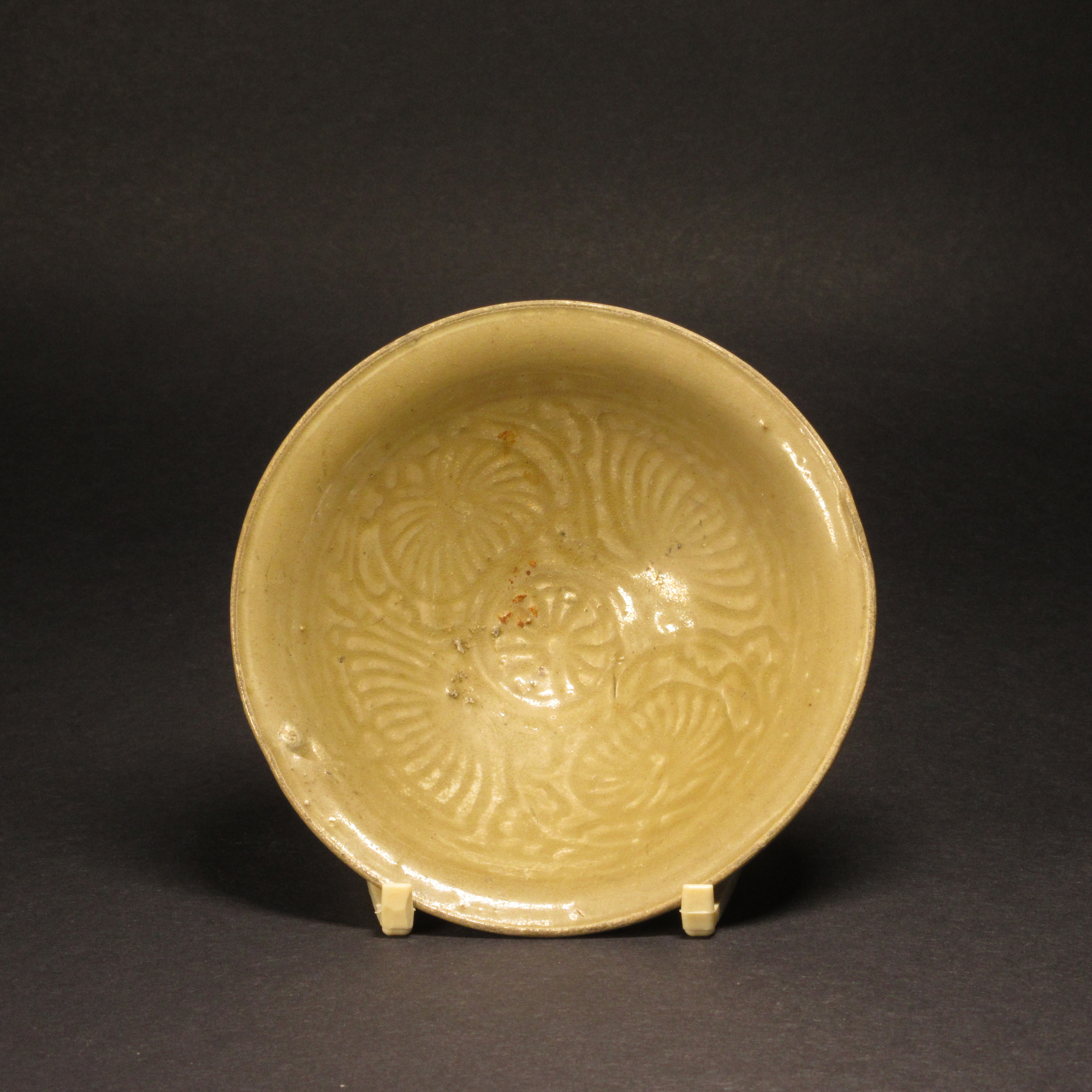
Material: stoneware
Dimensions: 11.8cm D
Provenance: Private Collection, UK
Notes: Of small size, this delightful gently rounded conical bowl is carved in the inside with five scrolling flower heads within a slightly everted rim, and is covered in an olive brown glaze, all raised on a circular foot.
Price: POA

AS401
Material: porcelain
Dimensions: 22cm diam.
Provenance: Private Collection, UK
Notes: Painted in bright famille rose enamels within a rouge-de-fer and gilt border, the arms are from an unidentified European, probably Dutch family, the crest being a bear's head muzzled in mural coronet. The motifs that decorate the rim refer to the qualities of an official or scholar. The royal umbrella symbolises an incorruptible official, the reeded instrument, known as a sheng, can also mean 'to rise in rank'. Variations of this pattern appear on many armorial wares decorated predominantly in rouge-de-fer and gold, produced in Jingdezhen between 1720 and 1735. The plate has a restored crack.
Price: £590

AS388
Material: porcelain
Dimensions: tray 19cm diam., jugs 12.5cm high
Provenance: Private Collection, UK
Notes: This little cruet set comprises a ewer and a sparrow beaked jug, both with lids and a quatrefoil tray. Beautifully ribbed baluster bodies decorated in bright famille rose enamels dating it to early Qianlong period. The decoration to the centre is of flowering peony branches as aground upon which a blue paulownia leaf panel is superimposed, itself overdecorated with scrolling white chrysanthemum. The borders are of opaque pink diaper with blue flowerheads at the corners, the handles are enamelled in iron red. Used for oil, vinegar, mustard, pepper etc. 18th Century table cruets are extremely rare survivors, and rarely appear on the market.
Price: POA
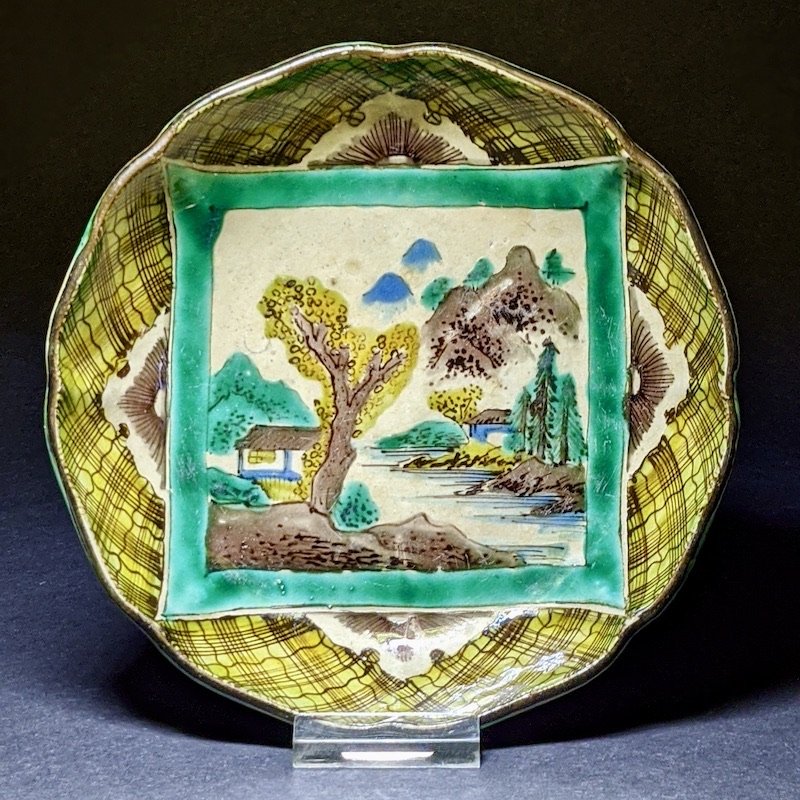
AS391
Material: porcelain
Dimensions: 15 x 4cm
Provenance: Private Collection, UK
Notes: Decorated in the Yoshidaya style, this charming shallow lobed bowl is painted to the centre with a square landscape depicting two thatched cottages on opposite banks of a river with trees and shrubs, and tall mountains disappearing in the distance. This panel is reserved on a foliate and brocade ground. All rendered in subtle shades of green, aubergine, blue and mustard yellow. The reverse is in bright green with clouds, whilst the unglazed base has the two character mark Fuku drawn as a seal in mustard yellow enamel.
Price: £POA
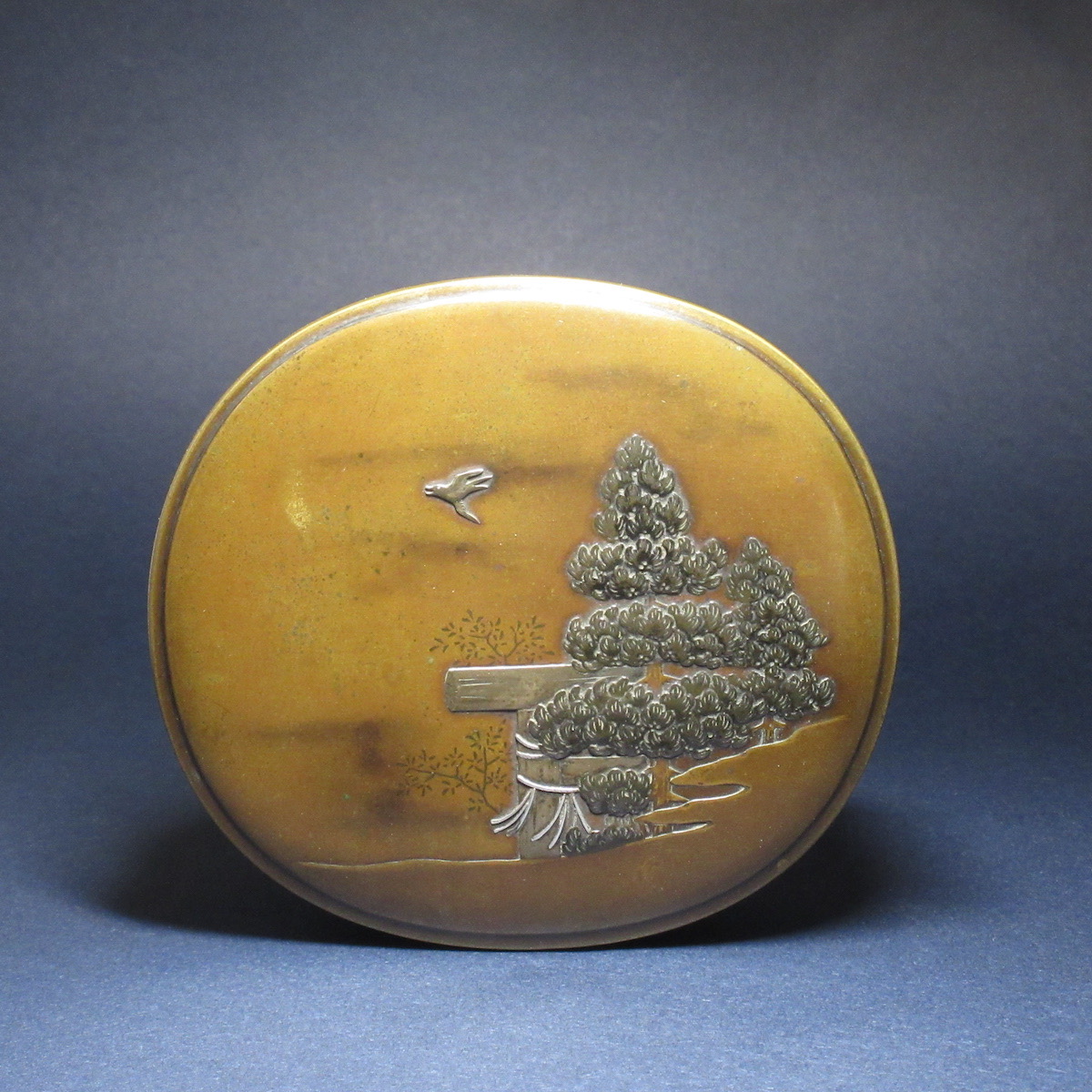
AS9
Material: bronze, mixed metal inlay
Dimensions: 12.8 x 11.5 x 5cm
Provenance: Private collection, UK
Notes: The cover decorated with silver and shibuichi in iro-e takazogan, takabori and kebori, with a tori gate behind a pine tree, the inside cover decorated in hirazogan with a moon in wispy clouds. By Jomi Eisuke (1839-1900), with engraved stylised seal mark "Jomi kore o sei" to base. Eisuke was a master craftsman from Kyoto who exhibited extensively at the Domestic Industrial Expositions in 1881, 1890 and 1895 and also won many prizes abroad at the International Expositions in Philadelphia (1876), Paris (1878, 1889 and 1900), Chicago (1893). His son, Einosuke continued to exhibit at St Louis (1904) and the Great Britain-Japan Expo in London (1910).
Price: POA
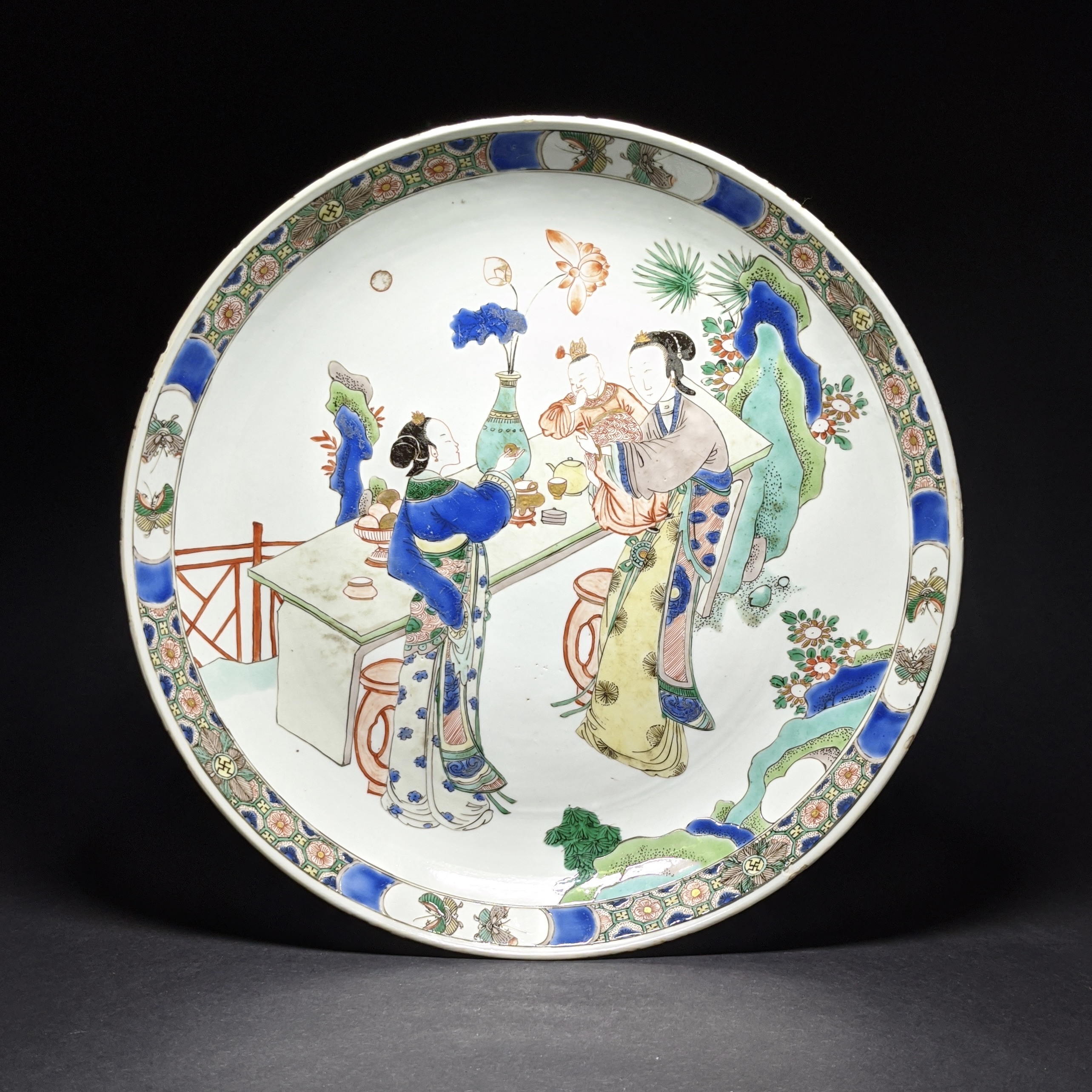
AS386
Material: porcelain
Dimensions: 27cm D.
Provenance: Private Collection, UK
Notes: This dish is appealing to both Chinese Export and Chinese Taste collectors. It is decorated in translucent famille verte enamels and depicts a mother and child being offered a sweet by an attendant. The figures stand beside a pair of cinnebar lacquer stools and hardwood table laden with food, tea, vase with lotus stems and a bronze tripod censer. All this, in an ornamental garden beneath a pale moon, within a border of diaper pattern and reserved panels of butterflies. The base has a double circle in underglaze blue with lotus mark. Rim is fritted.
Price: POA
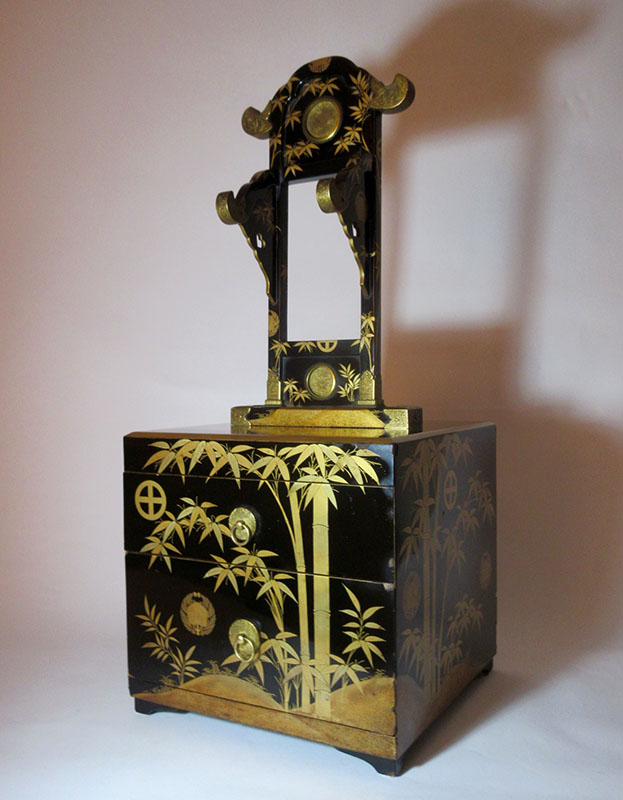
Material: lacquer, wood, copper
Dimensions: 64 x 28 x 28cm
Provenance: Private Collection, UK
Notes: Used for displaying a mirror (kagami) and to contain toilet utensils. This kyodai still contains dressing accessories.
Price: POA

AS161
Material: porcelain
Dimensions: 17cm
Provenance: Private Collection, UK
Notes: Very rare model of monk or sage, seated on rockwork in flowing robes, gently holding a Pekinese puppy in his hands. The Buddha encouraged his disciples to show compassion to all animals (Dīgha Nikāya 5). Figures decorated in famille verte enamels on biscuit are usually found on porcelains of the Kangxi period.
Price: POA
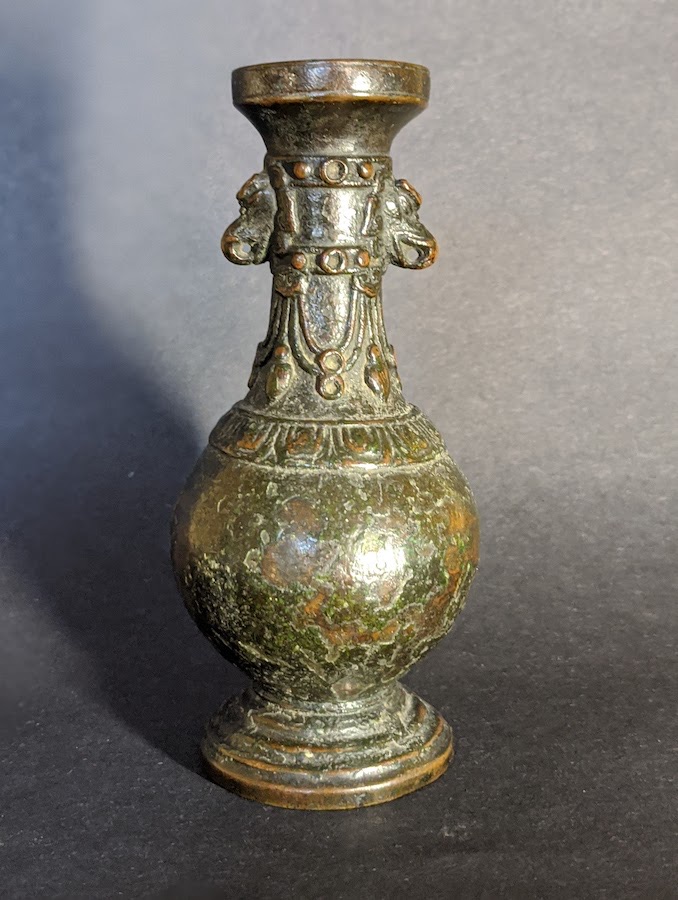
AS382
Material: bronze
Dimensions: 13.5 x 7cm
Provenance: Private collection, UK
Notes: This charming 17th Century vase probably belonged to a monk or scholar, and sat on his table as a container for implements. The upright rim has a faint diaper pattern, above a slender neck with jewelled collars hung with silk pendants from ruyi heads. The open circlets probably once contained tiny coral or turquoise onrmants. There are twin Baku head mask handles. The shoulder has a lappet collar, and it all resets on a multi-stepped circular foot. Allover is an ancient patina worn away in places.
Price: POA

AS295
Material: Porcelain
Dimensions: 16cm long
Provenance: Private Collection, UK
Notes: This small early 18th Century teapot is so simply decorated it invites comparison to the Zen aesthetic of Japanese Art. Each side is painted in underglaze blue, overglaze red and gilt highlights with a single branch of flowering prunus, the blossoms in both in bud and full bloom.Further branches appear on the cover, and the spout and handle are decorated with florets. There are iron red 'pinch' marks where the spout and handle join the body.
Price: £775

Material: bronze
Dimensions: 11 x 2.8cm
Provenance: Private Collection, UK
Notes: This gilt bronze buckle is modelled with the mythical animal mask hook and is mounted with two ancient cast bronze coins. The circular coin is a Wu-Shu (worth 5 Shu) and the rarer spade coin is a Huo-Pu (worth 25 Wu Shu or 125 Shu). The higher denomination coin was minted for only a short period during the Wang Mang interregnum (7-23 AD) between the end of the Eastern Han and beginning of the Western Han Dynasties. The bronze buckle bears an impressed stamp.
Price: £750
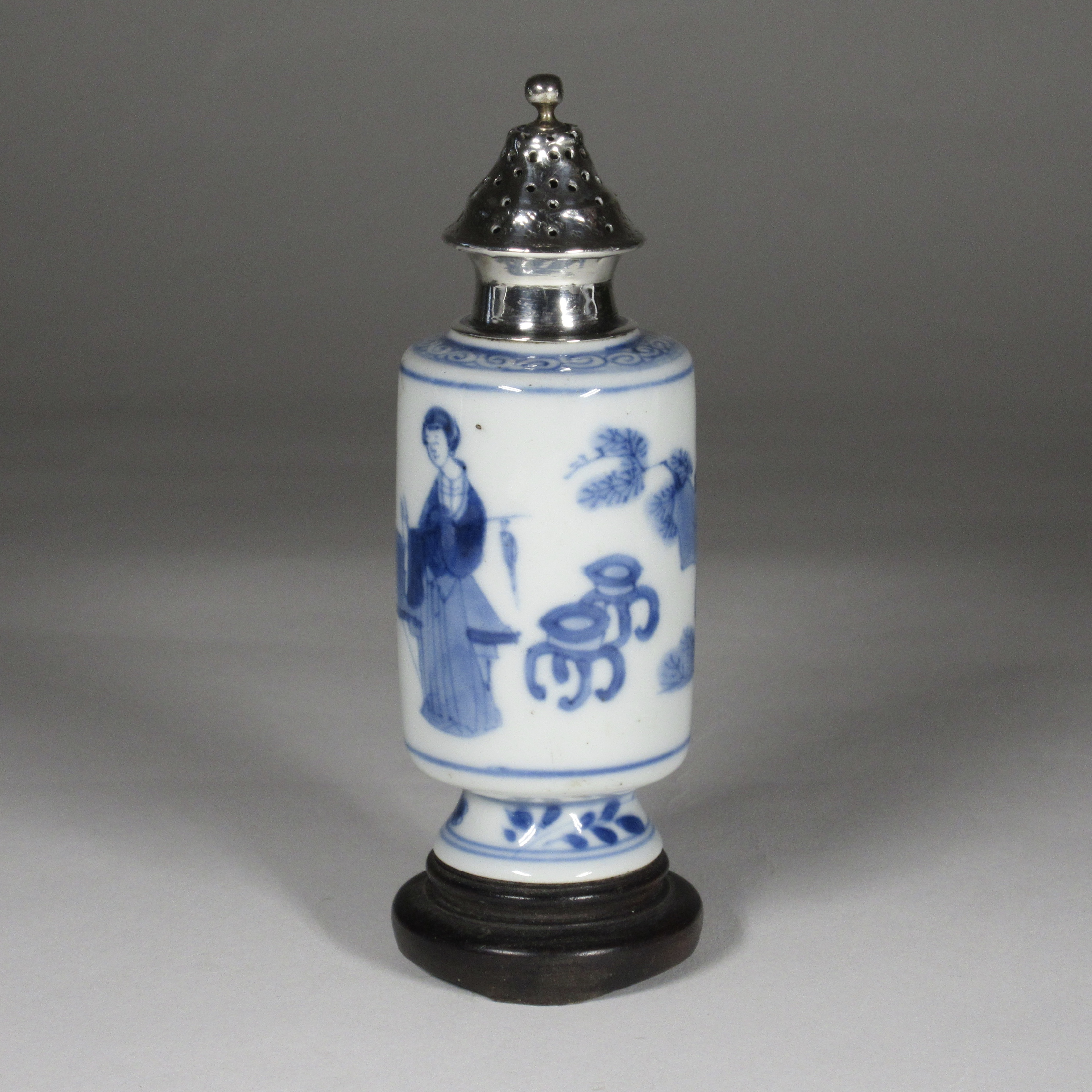
Material: porcelain, silver
Dimensions: 11cm
Provenance: Private Collection, UK
Notes: Well painted with two elegant women conversing beside a table, a parrot on a swing behind one, a pair of low tables or stands behind the other, divided by an ornamental rock with pine sapling, cloud collar at the shoulder and floral border at the socle foot, mounted with pierced conical silver cap.
Price: £850
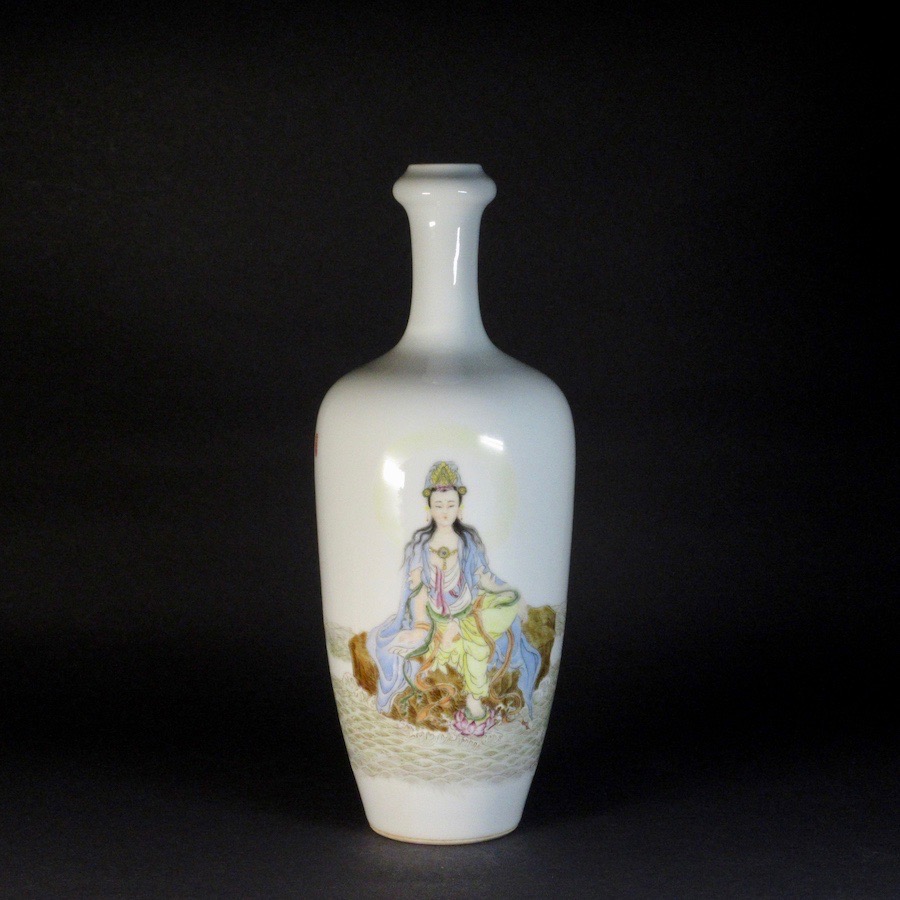
Material: Porcelain
Dimensions: 25.4cm H.
Provenance: Private Collection, UK
Notes: Beautifully painted in muted famille rose enamels with Guanyin, the goddess of Mercy, seated on a rock in a river, with one foot resting on a lotus. The reverse with poetic inscription in black characters and three red seals. Base with four character Jurentang mark in red seal script, reading "Hall Where Benevolence Resides".
Price: POA

Material: Porcelain
Dimensions: 11.5cm H.
Provenance: Private Collection, UK
Notes: The pear-shaped body painted in bright famille rose enamels with a long-tailed bird perched on a flowering camellia beside a peony shrub, below a black ruyi-head and drop pendant collar at the rim. Base with four character Jingdezhen Zhi mark in red seal script.
Price: £450

Material: porcelain
Dimensions: 12.5cm D.
Provenance: Private Collection, UK
Notes: This chrysanthemum fluted bowl is beautifully painted in muted famille rose enamels with a cricket, grasshopper and cicada perched on flowering chrysanthemum, peony and lotus all beneath a gilt rim, the base is marked in red seal script with six-character Tongzhi reign mark.
Price: £590
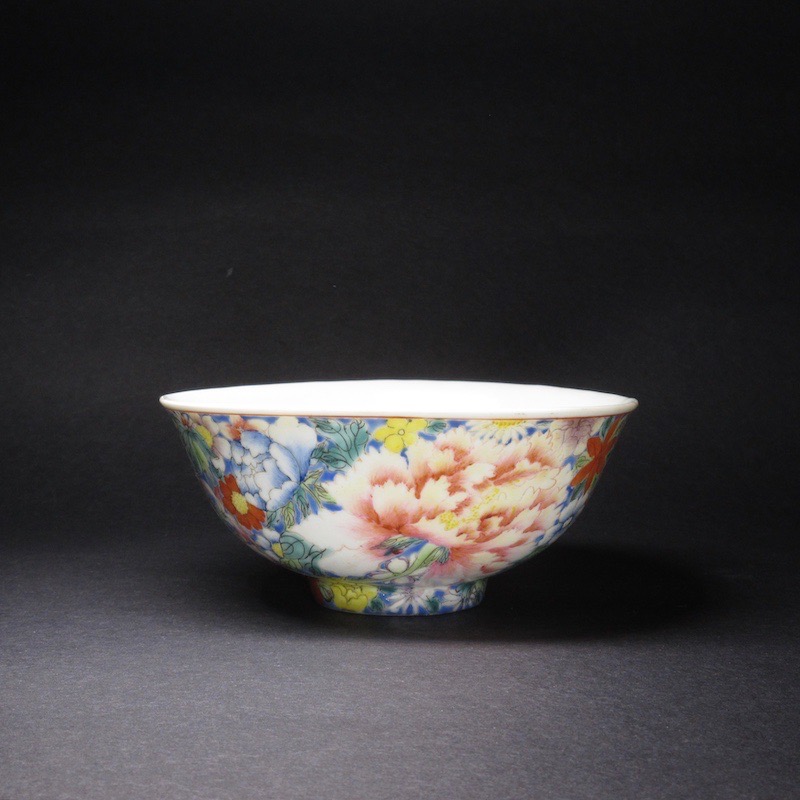
Material: porcelain
Dimensions: 12.5cm D.
Provenance: Private Collection, UK
Notes: This delightful bowl is densely decorated with the so-called mille fleurs (thousand flowers) pattern in pastel famille rose enamels. the inside is centred with a longevity shou roundel, the base bears a Qianlong six-character mark in red seal script.
Price: £580
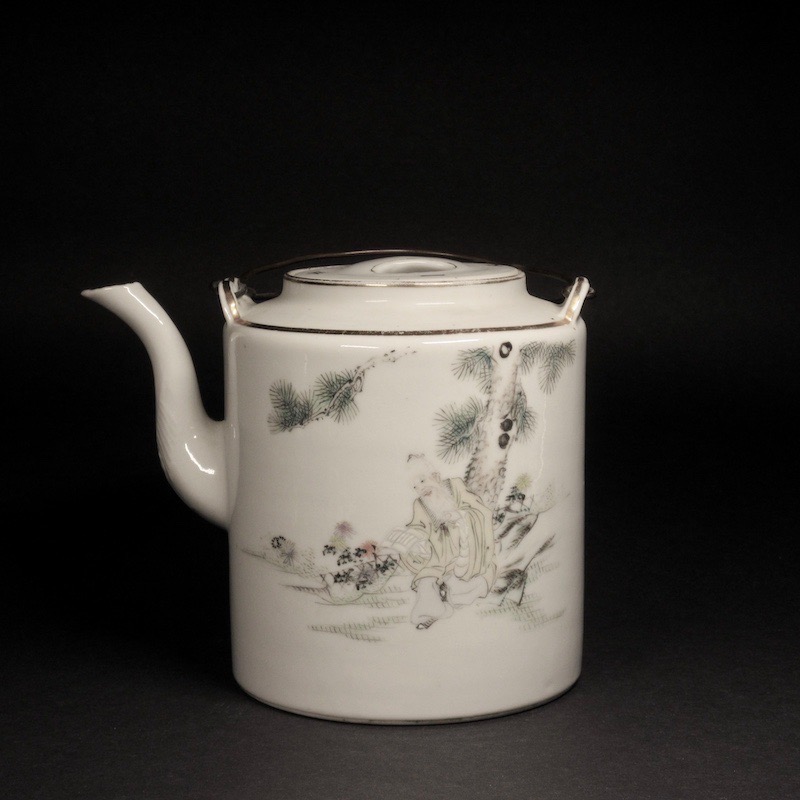
Material: porcelain, copper wire
Dimensions: 13cm H.
Provenance: Private Collection, UK
Notes: One side of this teapot is painted in the literati style with an elderly scholar reading a book whilst seated under a pine tree, subjects emblematic of long life. The reverse with seven character poetic inscription and two line signature with red seal mark. Lid with four characters.
Price: £550

Material: porcelain
Dimensions: 12cm D.
Provenance: Private Collection, UK
Notes: This octagonal pedestal dish is painted in the Qianjiang (literati) style with a rural landscape, with thatched cottages nestling in in a hilly valley beside a river with a small stone bridge, within gilt rim. Signed with three characters and artist's seal. Base is marked with red four-character Guangxu reign mark.
Price: £990
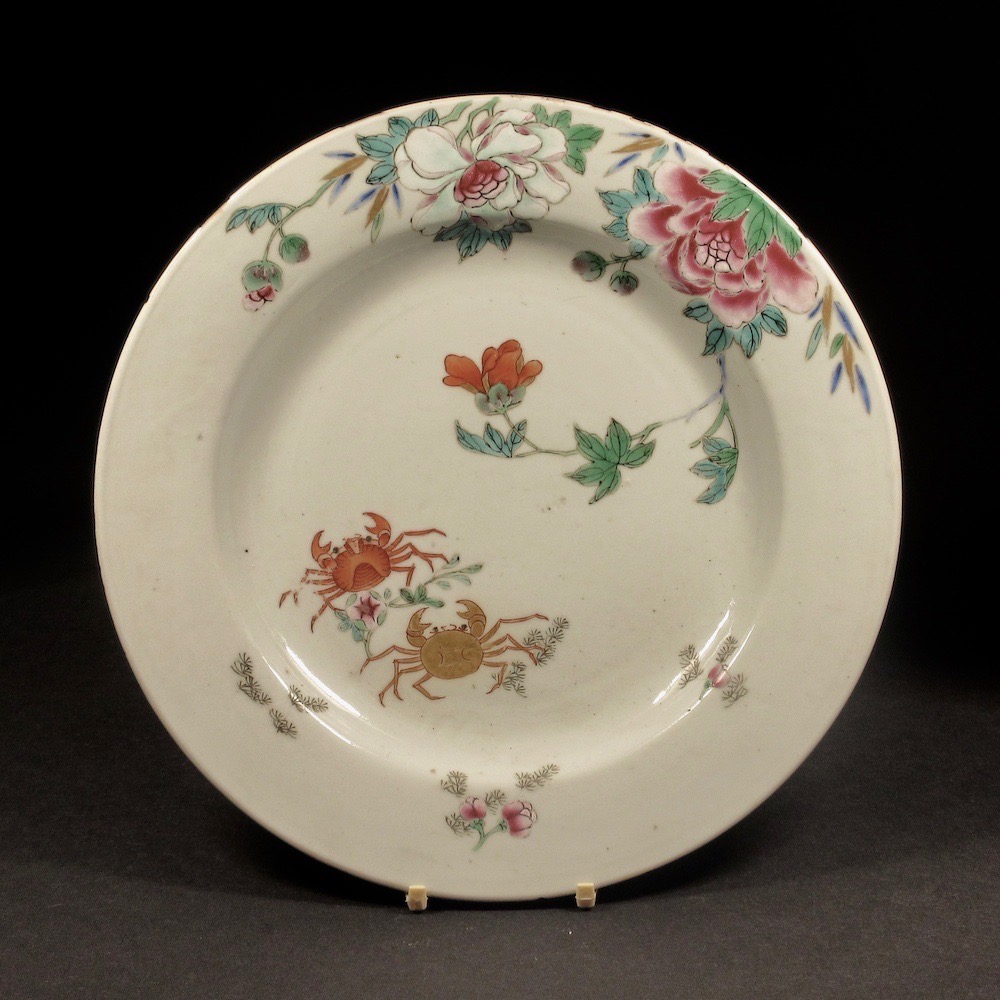
Material: porcelain
Dimensions: 23cm D.
Provenance: Private Collection, UK
Notes: The Chinese words 'crab' (蟹) and 'harmony' (协) are homonyms pronounced 'xie'. Two crabs therefore symbolise marital harmony. The crab is also used to symbolise success in the imperial examination system. The Chinese word for the crab's shell (jia 甲) has the additional meaning of "first" as in achieving the highest score in the examination to become a government official. Peonies symbolise the month of Summer. Compare with a similar plate in the Drayton Hall Collection, South Carolina, USA.
Price: £290

Material: porcelain
Dimensions: 23cm D.
Provenance: Private Collection, UK
Notes: This dish is beautifully enamelled in the famille rose palette with the Three Star Gods and attendants. Each immortal is dressed in flowing robes holding their respective attributes; Fu, the god of happiness holding a ruyi scepter symbolizing all wishes coming true, Lu the god of emoluments holding a scroll symbolizing an official career, and Shou, the god of longevity holding a peach and gnarled staff symbolizing long life. Attended by two maidens, within a gilt band at the rim.
Price: £400

Material: porcelain
Dimensions: 14cm D.
Provenance: Private Collection, UK
Notes: Decorated in famille rose enamels in a design known as the 'One Hundred Antiques'. It encapsulates the traditional scholar's interest in collecting objects which symbolised his refinement and education. It was fashionable to use antiques as decoration on porcelain in the late Ming and Qing periods.
Price: £450
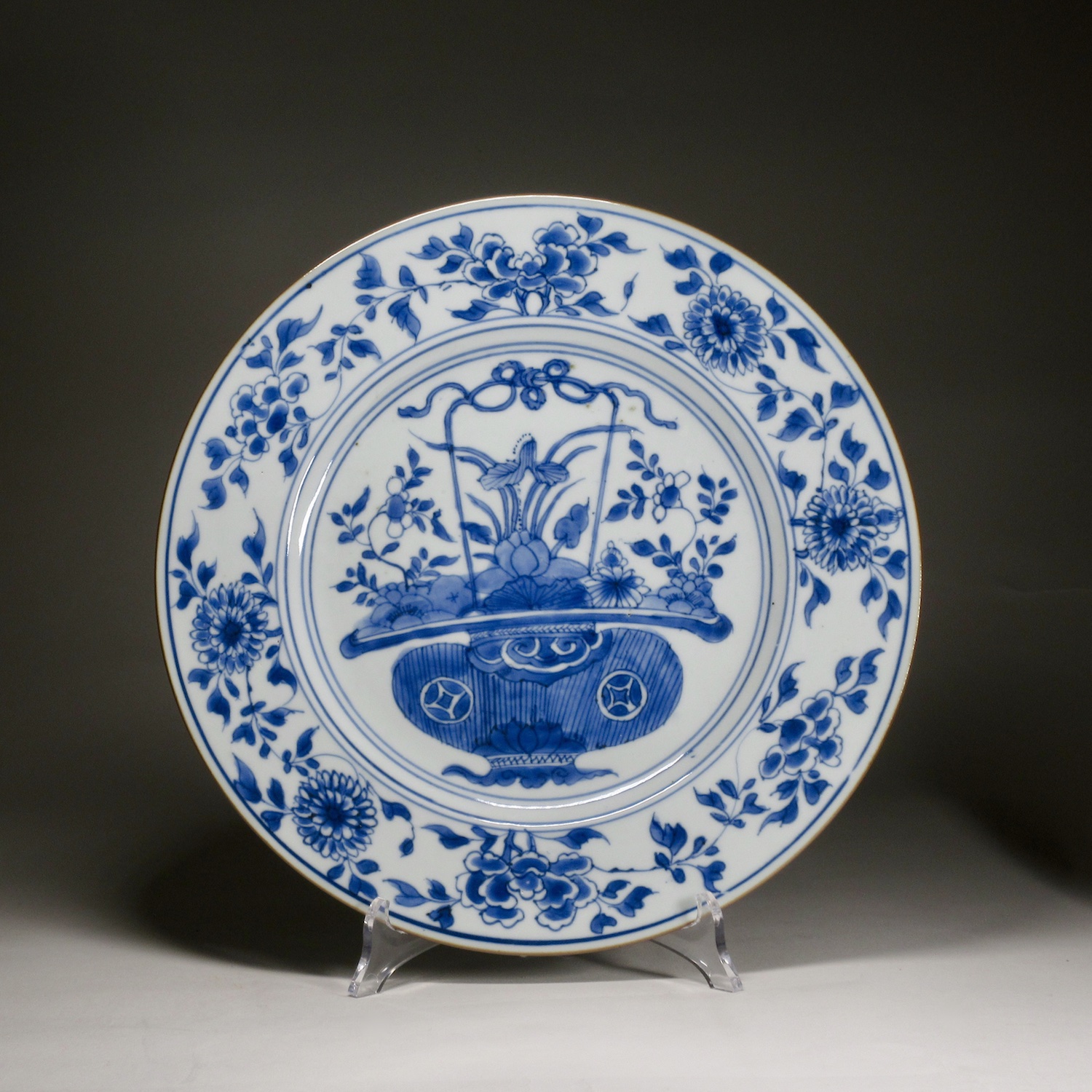
Material: porcelain
Dimensions: 27.6cm D.
Provenance: Private Collection, UK
Notes: Larger than the usual 9in. (23cm) standard dinner plate, this dish is painted in tones of bright blue with a large bronze urn of flowers including lotus and chrysanthemum, within multiple lines at the cavetto and a bold floral border of lotus, peony and chrysanthum.
Price: £950
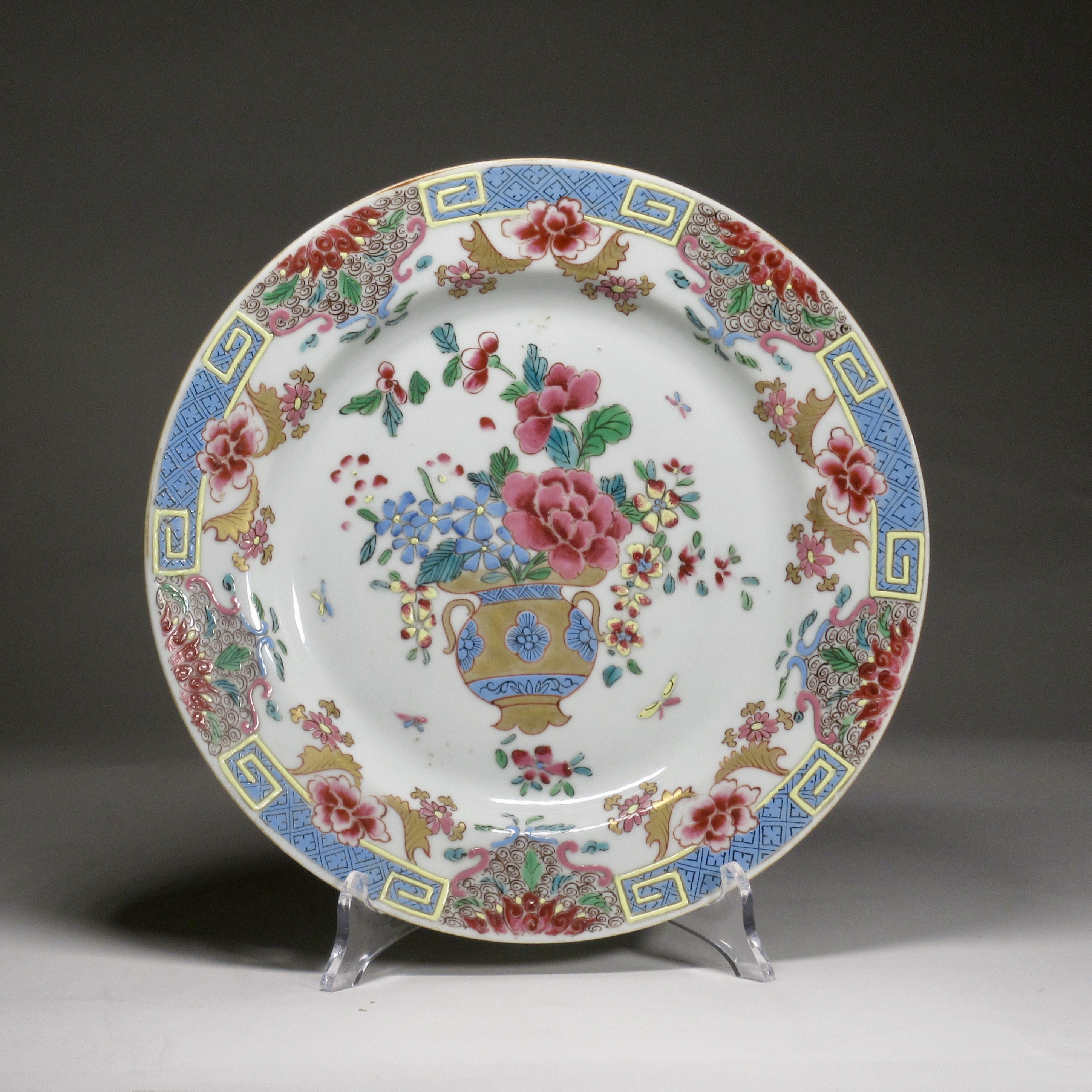
Material: porcelain
Dimensions: 23.3m D.
Provenance: Private Collection, UK
Notes: This export plate is boldly painted in famille rose (pink) enamels with a bronze urn of flowers including peony with five flying insects, all within a composite border of keyfret diaper panels, formal lotus on waves and lotus swags. Very much in the style of Yongzheng decoration but Qianlong or Jiaqing period.
Price: £350
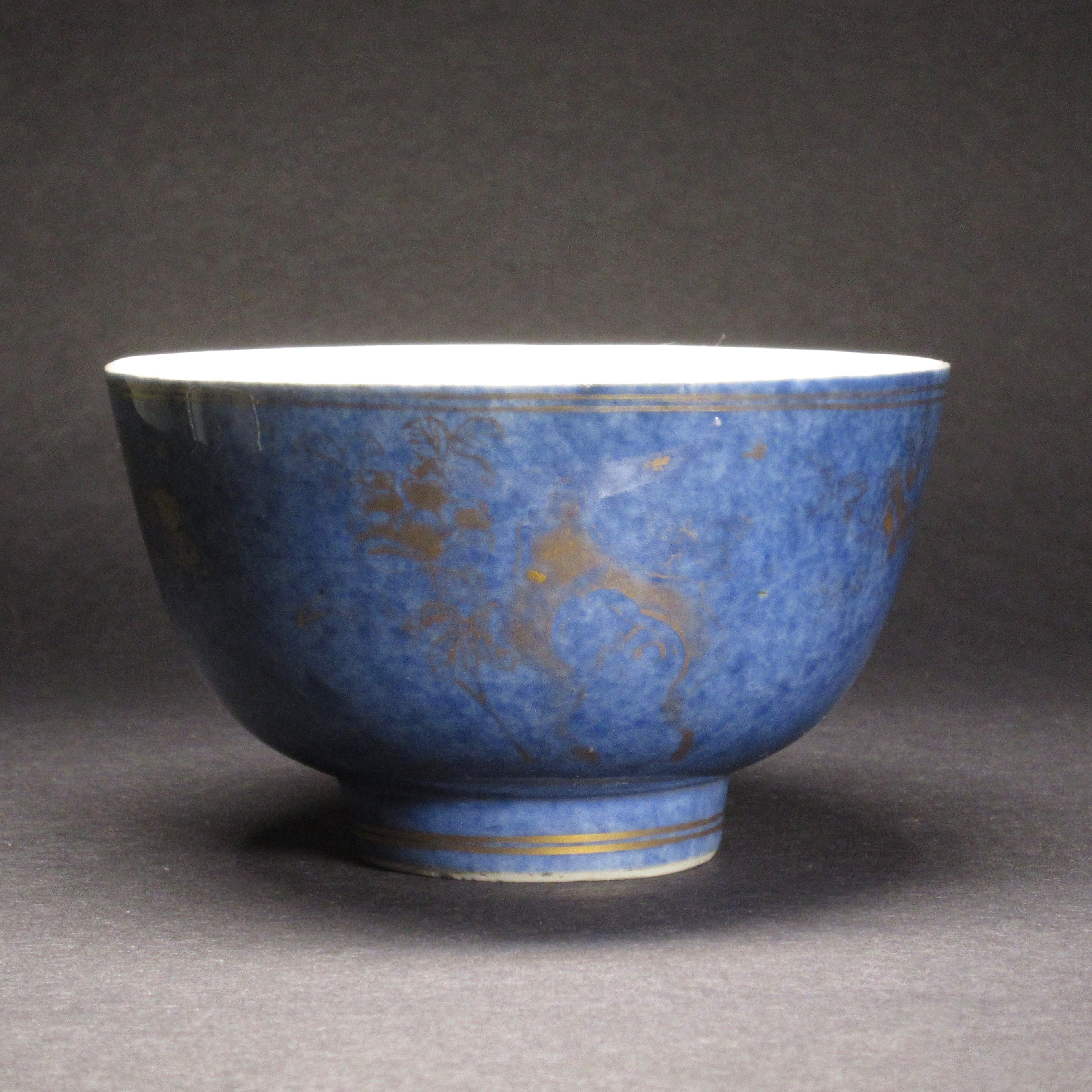
Material: porcelain
Dimensions: 9cm D.
Provenance: Private Collection, UK
Notes: Decorated to the outside in powder blue and gilt with ornamental rockwork and flowers, the inside centred with a small red and gilt flowerhead. Base with underglaze blue Ding mark within a double circle.
Price: £350

Material: porcelain
Dimensions: 13cm
Provenance: Private Collection, UK
Notes: Export porcelain. Unusually, enamelled in the Meissen-style with vignettes of Chinese figures sitting at a table and taking tea in the European manner.
Price: £575
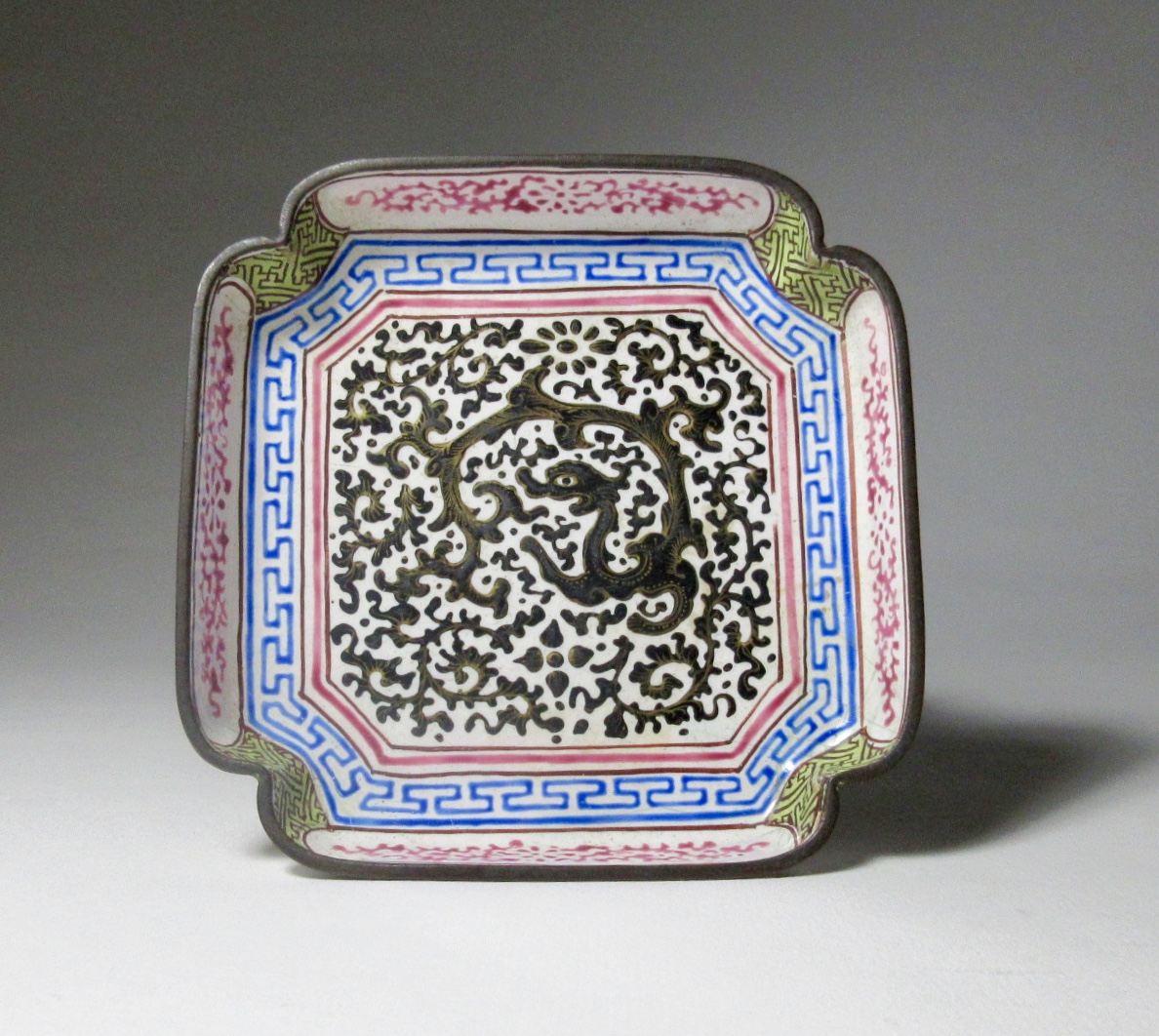
Material: enamel, copper
Dimensions: 9.4 x 9.4cm
Provenance: Private Collection, UK
Price: £375
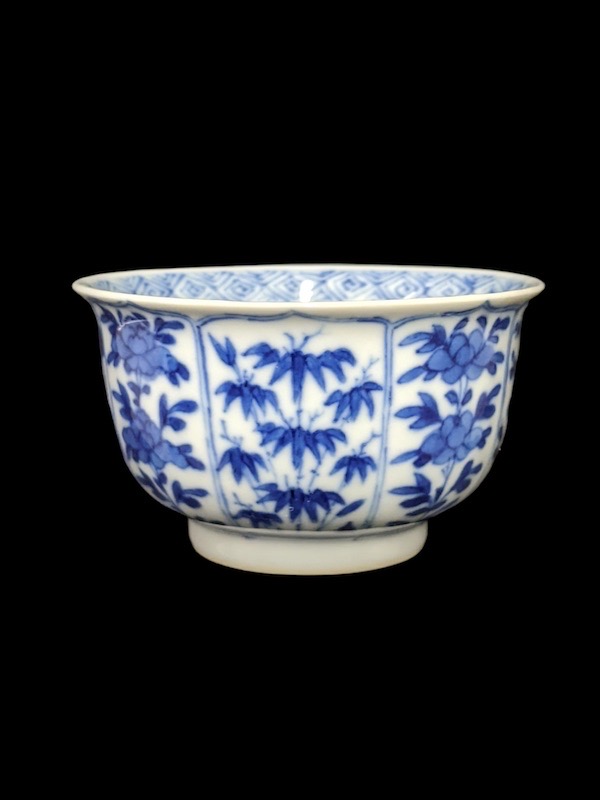
AS414
Material: porcelain
Dimensions: cm diam
Provenance: Private Collection, UK
Notes: Painted in shades of bright blue with pine, bamboo, plum and chrysanthemum, between four panels of peony. The inside is painted with a circular panel in the centre depicting a moth resting on grass, within four further flower sprigs and diaper band at the rom. Base with artemesia leaf mark.
Price: £350
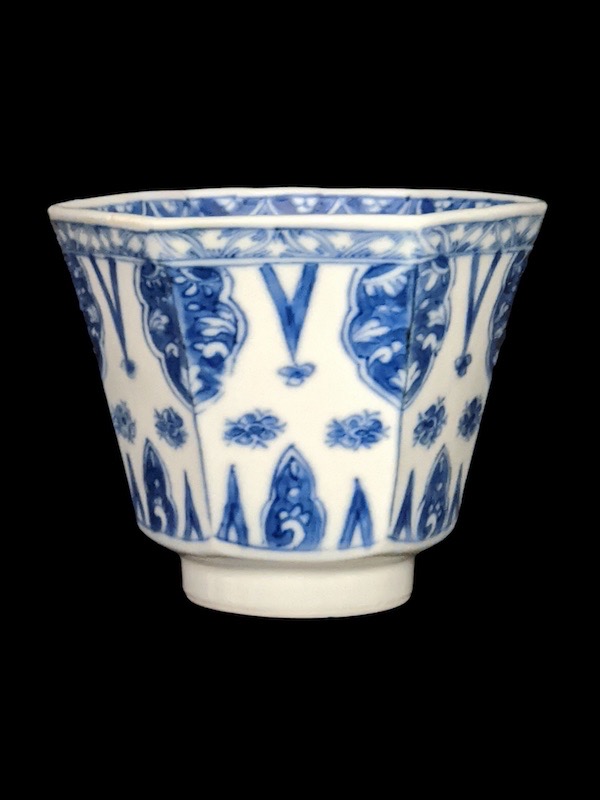
AS415
Material: porcelain
Dimensions: cm high
Provenance: Private Collection, UK
Notes: This tall cup is elegantly modelled with six sides tapering to a raised circular foot. Painted in shades of bright blue with stylised leaves and petals. Base with stylised character mark.
Price: £325
Enquiries, Payment, Shipping & Returns
We want to hear from you. Please request further images, condition reports, additional measurements etc. using the contact form, and we will respond directly. Please tick the GDPR compliance box if you wish to be updated about events at Ancestor Gallery in the future.
Payment is accepted by bank transfer. Once purchase has been agreed, a shipping charge will be added to the bill. After the total bill has been paid in full, your purchase will be shipped by courier within five working days to your home. Please note that shipping may be delayed if export permits are required for CITES related purchases.
Returns will be accepted within fourteen days of receipt at the purchaser’s cost to include freight, insurance, packaging. Insurance cover against loss and damage must be provided for the full cost of the item. Items must be returned in the same condition as when they were shipped, and will not be accepted if damaged or altered in any way. Refunds will only be issued once inspected and received. Any claim for items damaged in transit must be reported to us within two days of receipt with full written details and images by email.
